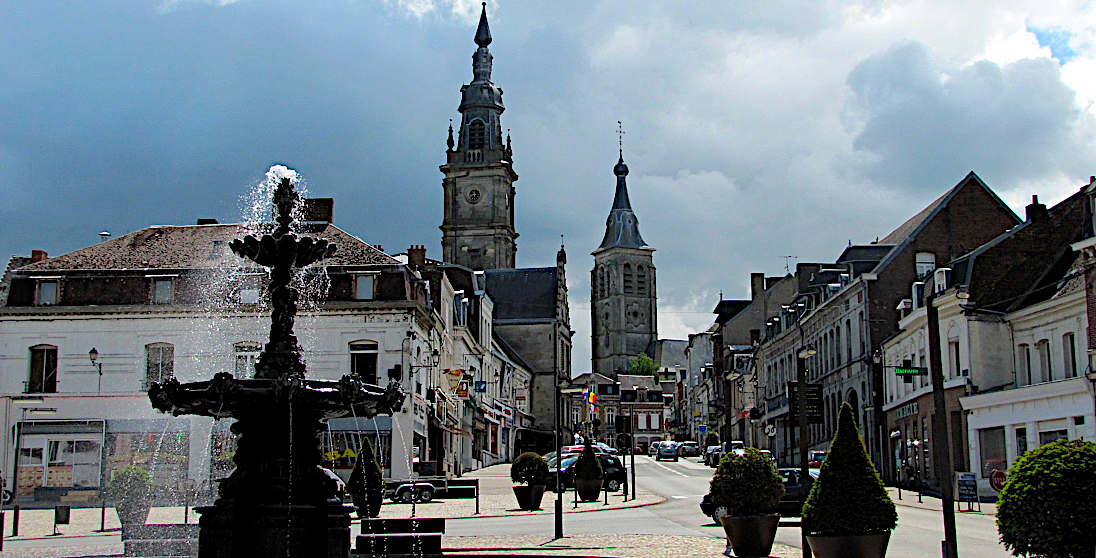
Northern France - an area guide
Discover the Nord and the Pas-de-Calais - the northern tip of France
- Explore France ►
- Essential pages
- Travel in France
- Where to go
- What to see and do
En
français ► Le Nord de la France
About-France.com
- the connoisseur's guide to France
| Page index ► | Regional overview | Main tourist sites |
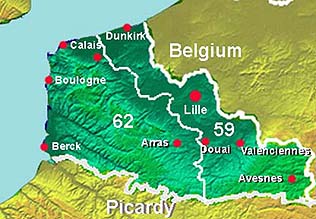 The
Nord and Pas de Calais area
The
Nord and Pas de Calais areaThis is the region of France that is most easily accessible for day trips or short breaks from the UK or Benelux countries.
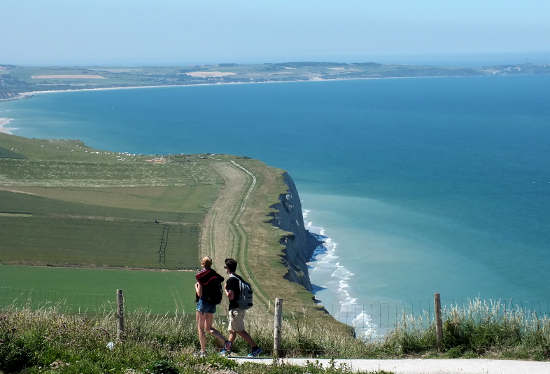 Coastal footpath on the Opal
Coast, south of Calais
Coastal footpath on the Opal
Coast, south of Calais In historic terms, this area, the far north of France, covers most of what was once the French part of Flanders, and the old province of Artois. Yet if we are to be quite honest, it is not a area that people in France tend to think of in terms of tourism.
That being said, it is nevertheless a part of France that has plenty to offer in its own way: the "Cote d'Opale", or Opal Coast, is an attractive west-facing coast with chalk cliffs, elegant resorts, and many sandy beaches; inland there are many areas of unspoilt countryside, particularly in the Pas de Calais. The area has many interesting towns and cities starting with Lille, the regional capital, and one of the great historic cities of Flanders; other interesting towns include Arras, Saint-Omer, Boulogne, Douai and Valenciennes, and there are many more places and sites of interest. One factor that is above all in favour of the Nord–Pas-de-Calais as a place to visit is its proximity to the densely populated areas of the south of England and the Low Countries. Lille is under two hours train journey from London by Eurostar, and Calais is even closer (though unfortunately few Eurostars from London actually stop there...). For anyone travelling by car from the UK, this region is very accessible for a weekend break or short stay, taking advantage of the cheap short-stay return fares offered by Eurotunnel, P&O Ferries or DFDS Ferries. Though these have not been stunningly cheap while few people were travelling on account of Covid restrictions, expect some bargains from October onwards when Covid testing requirements are relaxed for returning travellers..
History:
Flanders and Artois were areas that lay historically at the heart of Europe; before becoming definitively a part of France under the terms of the Treaty of Utrecht in 1713, this region had been fought over by the French, the English, the Austrians, the Spanish and the Dutch. More recently, it was a region that witnessed the terrific carnage of trench warfare in the Great War (see WW1 sites and map), and the the evacuation of Dunkirk in the Second World War.
If the region was much fought over in past centuries, one of the reasons was its wealth. This part of France has fine agricultural land, mostly flat or with gently rolling hills, like the South Downs in England: it was part of
 the great
European
cloth-weaving area, and the weavers and tapestry-makers of Lille, Arras
and Valenciennes were famed throughout Europe. The fine historic
squares of Lille and Arras bear witness to a prosperous past, as do the
great belfries and fine churches of towns like St. Quentin and Douai.
the great
European
cloth-weaving area, and the weavers and tapestry-makers of Lille, Arras
and Valenciennes were famed throughout Europe. The fine historic
squares of Lille and Arras bear witness to a prosperous past, as do the
great belfries and fine churches of towns like St. Quentin and Douai.But it was in the nineteenth century that this part of France built its modern identity. From its weaving tradition grew a modern textile industry, powered by the area's plentiful underground resources of coal; and from that grew much more. Nord-Pas-de-Calais - and notably the department of the Nord - was for a long time France's great industrial heartland. Lille was to France what Birmingham was to England, the capital and hub of a seething industrial complex covering mining, cotton, tranformation industries, transport and agriculture. It grew to be, and is to this day, the most densely populated region of France outside the Paris region.
Like neighbouring industrial regions across the border in Belgium, and like similar areas in Britain, the USA and other countries, industry in the north of France went into economic decline in the 1970's, as the industrial age came to an end; factories went out of business, the mines were closed down, and the future looked sombre. Since then, the area has done much to reinvent its economic base, aided by the fact that it lies in the economic heartland of Europe, the triangle between Paris, Cologne and London. Nonetheless, Nord–Pas-de-Calais remains the area of France with the highest unemployment rate (about 12.9% in the third quarter of 2015, three points above the national average).
Main tourist attractions in North France and Pas de Calais
The "Nord" department is almost 200 km from northwest to southeast. Sites in the Nord department are grouped by area, for easier holiday planning. The Nord-Pas-de-Calais region has four major art galleries (■)Areas and multi-sites:
- The Belfries of France and Belgium (59, 62, + Belgium): over 60 medieval Renaissance or baroque belfries, listed as a dispersed UNESCO world heritage site.
- Marais Audomarois (59 n , 62): the St.Omer fens, including a major wetland area with rich bird life, and a nature reserve.
- Sites, memorials and museums commemorating the Great War. See First World War sites in France
Nord department (59) - northern area:
- Cassel Attractive small town sitting on a hilltop dominating the plains all around. Old houses, market square.
- Dunkerque Port city with famous carnival. Marina, Art gallery.
Nord department (59) - central area:
- Lille: Regional capital, historic centre with fine squares, Vielle Bourse, a fine 17th century ensemble, the medieval Palais Rihour, Minibus city tours in eight languages, the zoo (free), and the ■ Palais des Beaux Arts, the best provincial art gallery in France.
- Roubaix (59) : "Art and history town" - The town, once a major textiles city, has an interesting heritage of old textile mills and urban architecture.. ■ La Piscine art gallery has a major collection of French 19th and 20th century art, housed in and around a former art-deco 1930s swimming pool.
- Avesnes-sur-Helpe (59). Ecomusée: Living textile museum telling the story of the region's industrial heritage.
- Le Cateau (59) ■ Matisse museum, in the town where Matisse was born. Significant collection. Close by is the village of Ors where war poet Wilfrid Owen died in 1918, and is buried. Historic brewery, with visits.
- Le Quesnoy (59) Small town, one of the finest fortified cities in France, with 3.5 km of ramparts. The 17th century ramparts were designed by Vauban and consolidated until the 19th c. Bike hire at the tourist office.
- Arques (62): Glassworks factory visit. Arques crystal is among the most famous in France.
- Arras (62): Capital of Pas-de-Calais, the city boasts a fine Dutch baroque square and belfry, one of the Unesco sites. Wellington Quarry underground World War 1 museum.
- Berck
(62), or Berck sur Mer: Classic seaside resort in the
south of Pas de Calais. Long sandy beaches.
- Boulogne sur Mer (62): Classed as a "Town of art and history", Boulogne is an attractive seaport. Historic old town, surrounded by medieval ramparts, museum with a world-class collection of Egyptian antiquities. and Nausicaä, (► tickets) the French national Sea Centre, and one of the largest aquariums in Europe.
- Côte d'Opale (62): Attractive coastline south of Calais, with fine sandy beaches and coastal footpath.
- Eperlecques: (62). The notorious blockhouse from which V2 flying bombs were launched at London during the second world war. Museum and visits.
- Lens (62) : ■ Le Louvre Lens - an annexe of the Paris Louvre, permanent and temporary displays of works from the main Louvre, including many major works.
- Montreuil sur Mer (62) Small old town with fortifications and an attractive centre.
- St. Omer: (62) Gothic cathedral and St. Denis church.
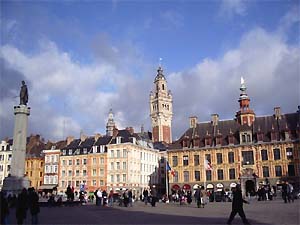
Lille, the main square and belfry.
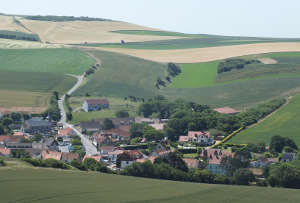
A village in rural Pas de Calais
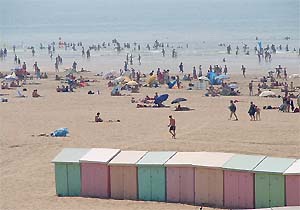
The beach at Berck: tourists from England feel very much at home!

Sculpture area in the unique Art-deco Piscine gallery, Roubaix, once a swimming pool - now one of the top six provincial art galleries in France
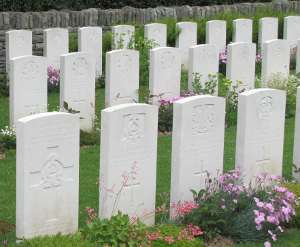
The First World War raged over much of this region of France.
Photo
top of page: Le Cateau, home to a remarkable Matisse museum and
historic brewery museum
The area of Nord– Pas-de-Calais, and more generally the Hauts-de-France region, is the part of France closest to the UK, and most easily accessible for short visits from Britain and Benelux. Tickets for many of the region's attractions can be booked online in advance on Tiqets.com
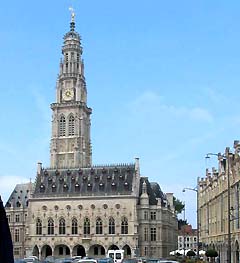
Arras - Hotel de ville
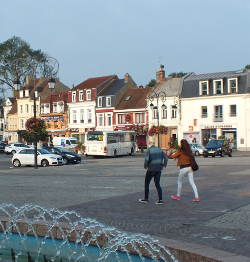
The small town of Montreuil sur mer, south of Boulogne
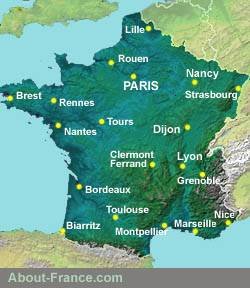
About-France.com partners as an affiliate with a number of travel product or service providers, and may receive a small commission of some sales generated. This has no impact at all on the cost of the services provided.
Text and photos Copyright © About-France.com
Except: Photos of : Arras by Paul Hermans, Lille by Marie Lefrançois, and Berck beach by Stan - Licence Creative commons.
The area of Nord– Pas-de-Calais, and more generally the Hauts-de-France region, is the part of France closest to the UK, and most easily accessible for short visits from Britain and Benelux. Tickets for many of the region's attractions can be booked online in advance on Tiqets.com
Site
search
About-France.com
What are you looking for ? Where do you want to go?
About-France.com
What are you looking for ? Where do you want to go?

Arras - Hotel de ville

The small town of Montreuil sur mer, south of Boulogne

| ►► Site guide |
| About-France.com home |
| Full site index |
| About-France.com site search |
| ►► Principal chapters on About-France.com : |
| Guide
to the
regions of France Beyond
Paris, a guide to the French regions and their tourist attractions.
|
| Guide
to Paris Make
the most of your trip to Paris; Information on attractions, Paris
hotels, transport, and lots more.
|
| Accommodation
in France
The different options, including hotels,
holiday gites, b&b, hostels and more
|
| Tourism in France
The
main tourist attractions and places to visit in France - historic
monuments, art galleries, seasides, and more
|
| Planning
a trip to France
Information
on things to do before starting your trip to France.
|
| Driving
in France
Tips
and useful information on driving in and through France - motorways,
tolls, where to stay....
|
| The
French way of
life
A mine of information about
life and living in France, including
working in France, living in France, food and eating, education,
shopping.
|
Click here for
low-cost car hire in France
low-cost car hire in France
About-France.com partners as an affiliate with a number of travel product or service providers, and may receive a small commission of some sales generated. This has no impact at all on the cost of the services provided.
Text and photos Copyright © About-France.com
Except: Photos of : Arras by Paul Hermans, Lille by Marie Lefrançois, and Berck beach by Stan - Licence Creative commons.
